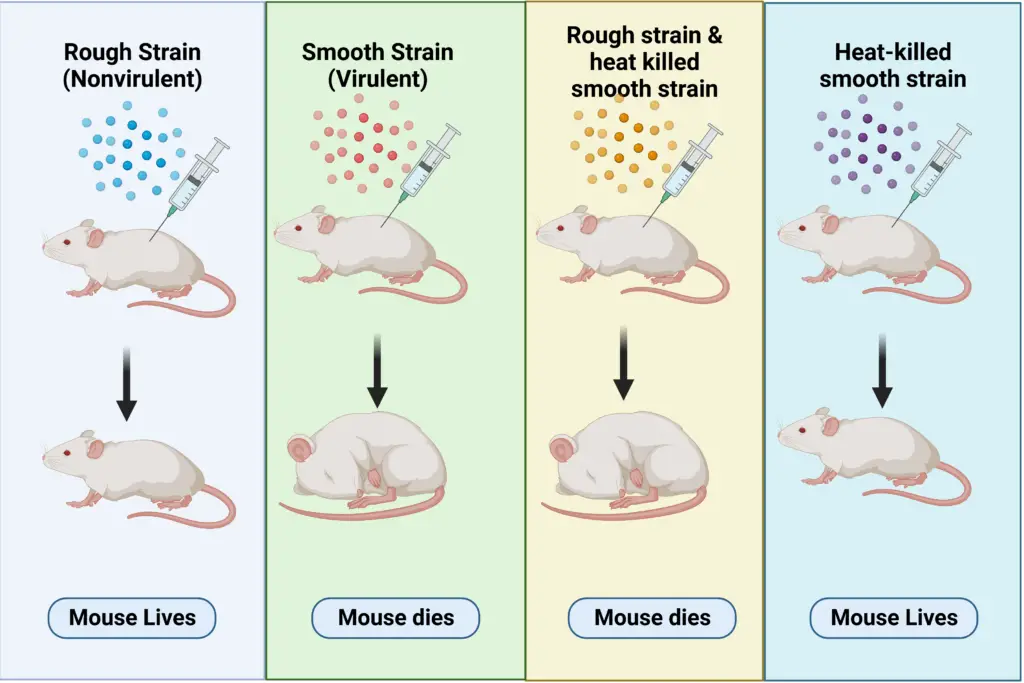- The hunt for genetic material began in the middle of the nineteenth century. The principle of inheritance was discovered by Mendel.
- Mendel concluded from his research that some ‘factors’ are transmitted from one generation to the next.
- Mendel’s Law of Inheritance served as the foundation for genetic material study. Keeping his conclusions in mind, subsequent scientists concentrated on chromosomes in their search for genetic material.
- Even though the chromosomal components have been identified, the material responsible for heredity is still unknown. It took considerable time for DNA to be accepted as the genetic transformation.
- Let’s examine the finding of genetic material and the Griffith experiment briefly.
Griffith Experiment & Transforming Principle
Frederick Griffith, a British bacteriologist, conducted a series of studies with Streptococcus pneumoniae bacteria and mice in 1928. Griffith was not attempting to detect genetic material; rather, he was attempting to produce a vaccine for pneumonia. Griffith utilised two strains of bacteria identified as R and S in his tests.
- R strain: When cultivated on a petri dish, the R bacteria developed colonies with distinct edges and a rough surface (hence the abbreviation “R”). The R bacteria were nonvirulent, meaning that when injected into a mouse, they did not induce illness.
- S strain: Colonies of S bacteria were spherical and smooth (hence the abbreviation “S”). The bacteria developed a polysaccharide or sugar-based coating that provided the smooth appearance. This coating shielded the virulent S bacteria from the mouse immune system, allowing them to thrive (capable of causing disease). Injecting mice with live S bacteria caused pneumonia and death.
Griffith, as part of his trials, attempted to inject mice with heat-killed S bacterium (that is, S bacteria that had been heated to high temperatures, causing the cells to die). Unsurprisingly, mice were not infected by heat-killed S bacterium.
When innocuous R bacteria were paired with harmless heat-killed S bacteria and injected into a mouse, the research took an unexpected turn. The mouse not only developed pnenumonia and died, but when Griffith took a blood sample from the deceased mouse, he discovered living S bacteria!

Griffith reasoned that the R-strain bacteria must have acquired a “transforming principle” from the heat-killed S bacteria, allowing them to “transform” into smooth-coated bacteria and become virulent.
Avery, McCarty, and MacLeod: Identifying the transforming principle
In 1944, Oswald Avery, Maclyn McCarty, and Colin MacLeod, three Canadian and American scholars, set out to find Griffith’s “transforming principle.”
To do this, they began with huge cultures of heat-killed S cells and, through a lengthy sequence of biochemical procedures (defined by painstaking experimentation), gradually purified the transforming principle by removing, isolating, or eliminating the other cellular components. By using this technique, they were able to collect minute quantities of highly purified transforming principle, which they could subsequently examine to determine its identity.
Several lines of evidence suggested to Avery and his colleagues that DNA may be the transformative factor.
- The refined substance yielded negative results on chemical tests designed to detect proteins, but a highly positive result on a test designed to detect DNA.
- The ratio of nitrogen to phosphorus in the elemental composition of the purified transforming component closely approximated that of DNA.
- Enzymes that breakdown protein and RNA had minimal influence on the transforming principle, whereas enzymes that degrade DNA removed the transforming activity.
All of these results pointed to DNA as the most plausible transformative agent. However, Avery interpreted his data with caution. He concluded that it was still plausible that a small bit of a contaminated chemical, and not DNA, was the actual transforming agent.
Due to this possibility, dispute lingered over DNA’s role until 1952, when Alfred Hershey and Martha Chase utilised a different method to clearly establish DNA as the genetic material.
DNA as Genetic Material
The Griffith experiment was a pivotal moment in the discovery of genetic material. However, it failed to explain genetic material’s biology. Oswald Avery, Colin MacLeod, and Maclyn McCarty continued the Griffith experiment in quest of the biochemical nature of the genetic material. Their finding replaced the notion of protein as genetic material with that of DNA as genetic material.
Avery and his group isolated and purified proteins, DNA, RNA, and other macromolecules from bacteria of the S strain that had been destroyed by heat. They determined that DNA is the sole genetic material responsible for the transformation of R strain bacteria. They discovered that protein- and RNA-digesting enzymes did not inhibit transformation, but DNase did. Although it was not acknowledged by others, they concluded DNA as genetic material.
- Text Highlighting: Select any text in the post content to highlight it
- Text Annotation: Select text and add comments with annotations
- Comment Management: Edit or delete your own comments
- Highlight Management: Remove your own highlights
How to use: Simply select any text in the post content above, and you'll see annotation options. Login here or create an account to get started.